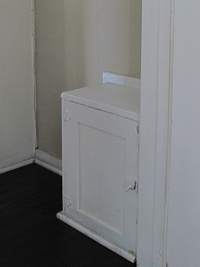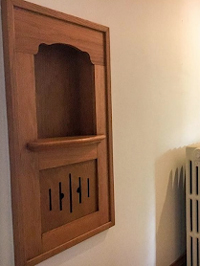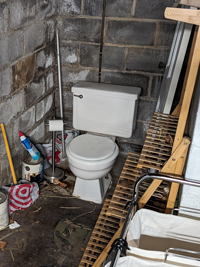- Home
- Resource Center
- Education
- C&N Library
- Hidden in the Walls: Uncovering Forgotten Home Features
Hidden in the Walls: Uncovering Forgotten Home Features
- Category:
- Homebuying & Homeownership
- Author:
- Chris Kirman
- Date:
- 06/10/25
Houses have always reflected the technology, lifestyles, and culture of their times. Across the decades, American homeowners tailored their homes to fit their visual preferences and practical needs. As technology developed, home features once considered trendy quickly fell out of fashion and function. To celebrate American Housing Month, we're looking to the past to explore antique home features that embody the style and spirit of their time, and may still be hidden in plain sight.
Coal Chutes
 People have always desired to buy and receive products as painlessly as possible. Today, packages are left on our doorsteps, but earlier Americans had their own methods. In the 1910s, most homes were heated by coal delivered straight to the house. To streamline the coal delivery process, homeowners installed coal chutes: small doors on the side of a home's exterior that drop down into a storage bin. Coal chutes decreased delivery time and prevented soot from being tracked through the house. While coal is rarely used to heat homes today, homes from the 1910s may still have rustic coal chutes sealed away in the walls.
People have always desired to buy and receive products as painlessly as possible. Today, packages are left on our doorsteps, but earlier Americans had their own methods. In the 1910s, most homes were heated by coal delivered straight to the house. To streamline the coal delivery process, homeowners installed coal chutes: small doors on the side of a home's exterior that drop down into a storage bin. Coal chutes decreased delivery time and prevented soot from being tracked through the house. While coal is rarely used to heat homes today, homes from the 1910s may still have rustic coal chutes sealed away in the walls.
Razor Holes
The invention of the safety razor in 1903 made shaving at home easier and more affordable than ever. However, it also presented a problem: how do we dispose of all these razor blades? The garbage can was not an option, as most people at the time burned their trash, an ineffective method for disposing of metal. Eventually, American homeowners in the early 1900s began cutting small holes into their walls and medicine cabinets where they deposited used razor blades. The razors would slide into the space between the walls, out of sight and out of mind. So, if you find yourself renovating a home and discover heaps of rusty razors in the walls during demolition, have no fear!
Milk Doors
 Refrigeration is a modern marvel that allows us to store food for a long time before spoiling, but it wasn’t until the 1950s that most American homes had a refrigerator. Before then, Americans had to get creative. One clever solution was the milk door - a small, latched door on the outside of the house that opened into a cupboard or pantry. Because milk spoiled quickly, many families relied on daily milk deliveries. These doors allowed milkmen to drop off bottles without needing to enter the home. Today, supermarkets and refrigerators have made milk delivery (and milk doors) obsolete, but if your home still has one, it’s a charming piece of history and a great conversation starter.
Refrigeration is a modern marvel that allows us to store food for a long time before spoiling, but it wasn’t until the 1950s that most American homes had a refrigerator. Before then, Americans had to get creative. One clever solution was the milk door - a small, latched door on the outside of the house that opened into a cupboard or pantry. Because milk spoiled quickly, many families relied on daily milk deliveries. These doors allowed milkmen to drop off bottles without needing to enter the home. Today, supermarkets and refrigerators have made milk delivery (and milk doors) obsolete, but if your home still has one, it’s a charming piece of history and a great conversation starter.
Conversation Pits
The beating heart of any home is where good conversation takes place, whether in the dining room, living room, or back patio. In the 1950s, architects wished to invent a new social space in the home: conversation pits. Conversation pits are shallow pits in a room's floor bordered by cushioned seating. Indoor conversation pits usually feature a coffee table in the center while outdoor pits typically surround a fireplace. Despite being viewed as classy, conversation pits were not practical enough to achieve mainstream adoption. Most people opted for slightly sunken living rooms instead. However, the trend is making a comeback in recent years. Perhaps this time, the conversation pit will be here to stay.
Built-in Telephone Nooks
 Not so long ago, calls were made and received on corded landline telephones. At the onset of this new technology, those who could afford telephones often housed them in special nooks. Telephone nooks are shallow depressions in an interior wall with a small shelf to hold a phone and stationery for taking messages. Though mobile phones have largely displaced landlines, the phone nook lingers in some older houses, waiting to be repurposed. If you have an empty phone nook in your house, consider sprucing it up with a house plant, books, or a framed picture of a loved one.
Not so long ago, calls were made and received on corded landline telephones. At the onset of this new technology, those who could afford telephones often housed them in special nooks. Telephone nooks are shallow depressions in an interior wall with a small shelf to hold a phone and stationery for taking messages. Though mobile phones have largely displaced landlines, the phone nook lingers in some older houses, waiting to be repurposed. If you have an empty phone nook in your house, consider sprucing it up with a house plant, books, or a framed picture of a loved one.
Wood Paneling
Wood paneling is the quintessential symbol of the 1970s home. Though wood panel walls have been around for centuries, they hit a stride in the 70s due to the post-WWII baby boom. As children born in the 40s-50s reached adulthood, demand for homes grew rapidly. Synthetic wood paneling was used to meet this demand due to the material's low cost and quick installation. While considered outdated by some, wood paneling still carries a certain charm, a reminder of a “groovier” time.
The Pittsburgh Potty
 The Pittsburgh Potty is a unique feature found in some homes in Pennsylvania. It refers to a standalone toilet located in the basement. This innovation dates back to the industrial era when steelworkers returned home covered in grime and soot. To prevent tracking dirt throughout the house, homeowners installed a dedicated toilet, often with a sink, in the basement. This allowed workers to clean up downstairs without making a mess in the main living areas. Many homes in Pennsylvania and New York still have a Pittsburgh Potty, serving as a reminder of the region's industrial history.
The Pittsburgh Potty is a unique feature found in some homes in Pennsylvania. It refers to a standalone toilet located in the basement. This innovation dates back to the industrial era when steelworkers returned home covered in grime and soot. To prevent tracking dirt throughout the house, homeowners installed a dedicated toilet, often with a sink, in the basement. This allowed workers to clean up downstairs without making a mess in the main living areas. Many homes in Pennsylvania and New York still have a Pittsburgh Potty, serving as a reminder of the region's industrial history.
Some home features from the past may have faded, but they serve as fascinating reminders of how much homeownership has evolved. If your home still has some of these vintage elements or could use a few modern updates, now might be the right time to reimagine your space. C&N offers a variety of home-lending solutions to help make those renovations possible, including our flexible Line&Lock product.
With Line&Lock, you can tap into funds from a home equity line of credit and secure a fixed rate for specific projects, such as removing wood paneling, leveling a conversation pit, or covering up a coal chute. Whether you're restoring the charm of a bygone era or modernizing your home, C&N has the tools and expertise to assist you.
To learn more about our mortgage and home equity options, visit our mortgage section or speak with a C&N mortgage expert today.
Chris Kirman is a Mortgage Loan Originator at C&N’s Lancaster location, covering Lancaster, York and Chester Counties. Chris has over 21 years working in the Mortgage industry, with 17 of those years at community and regional banks, giving him a wealth of experience with personal, one-on-one customer experiences. He joined C&N in September of 2022 after spending time at Susquehanna Bank, Ephrata National Bank, U.S. Bank and Guaranteed Rate, Inc. Chris specializes in construction to permanent housing and financing for medical professionals.
After graduating from Cumberland Valley High School in Mechanicsburg, Chris studied Psychology at Penn State University. He is a member of Lancaster County Building Industry Association and often volunteers at Schreiber Center for Pediatric Development and Junior Achievement of South Central PA.
In his free time, Chris enjoys aquatic activities, spending summer weekends at the Delaware beaches and rooting on the Penn State Nittany Lions during football season. Chris and his family live in Lititz, PA.
“Specialized knowledge or guidance is needed even with the best of technology platforms or most independent of customer. Everyone thinks a rocket ship sounds great until they have to ride in one or fly it.”

